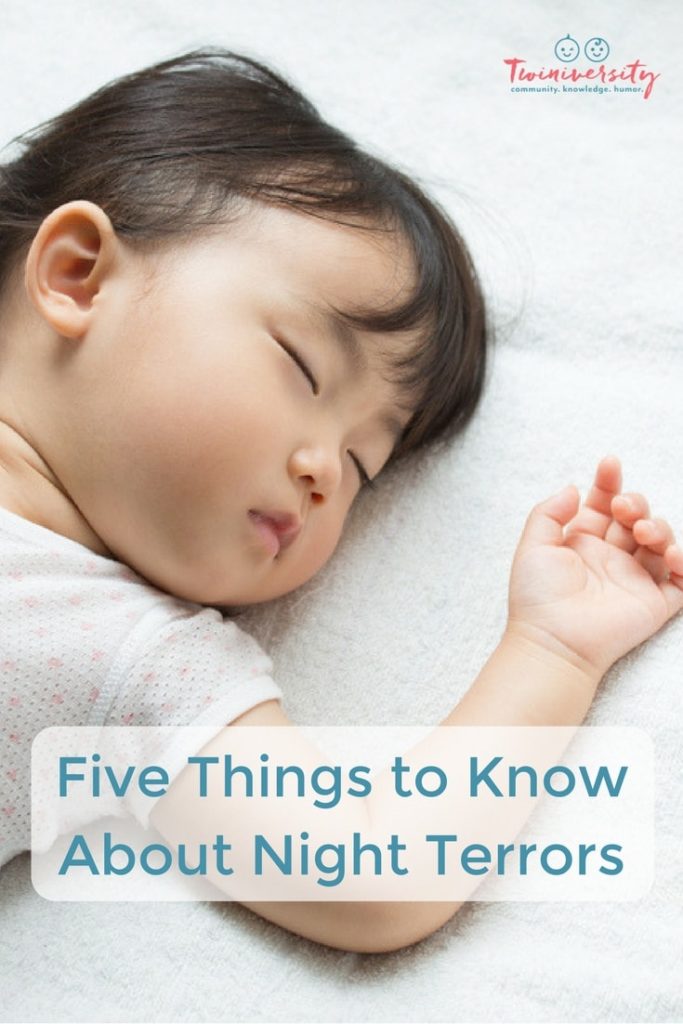Last updated on September 28th, 2021 at 01:55 pm
It’s a terrible feeling when you can’t comfort your own child. Besides the obvious concern for your child’s well-being, it is natural to feel inadequate as a parent, and to stress about why you can’t ease their fear and suffering. This is something that parents of children who suffer night terrors often experience. They can feel helpless and hopeless. The root of a lot of these feelings is the lack of understanding that often surrounds night terrors. Here are five things to know about night terrors.
1. Night Terrors are not the same as nightmares.
Almost everyone has nightmares but, according to the American Psychiatric Association, only 1-6% of children suffer from night terrors. So, how do they differ? When children suffer from nightmares, they will wake up, screaming or crying for the parent, and will usually be able to explain the nightmare (depending on age) and be soothed back to sleep by the parent. They will also often remember the episode the next morning.

Children suffering a night terror may also scream or cry, and may even have their eyes open and seem to be engaging with the parent, but they are not actually awake. They will often refuse any type of comforting, and may have no idea that the parent is there. When my daughter has a night terror, she will look right at me, without a flicker of recognition, and then often look over my shoulder intently (yes, it’s as creepy as it sounds). She pushes me off if I try to pick her up, and screams loud enough to wake the dead, or at least her sister in the next bed (and sometimes the neighbors next door.) The next morning, she has no recollection of what happened, although her sister sometimes snidely informs her, “You woke me up!”
2. Symptoms of Night Terrors are not the same for every child.
While night terrors are most common in children aged 3-12, they can occur in younger children, and can sometimes last into adulthood, although this is quite rare. My daughter experienced her first night terrors before her first birthday. As a completely inexperienced mom, I felt completely useless when I could not comfort her, and often ended up crying on the floor of the nursery. At that time, she mostly just screamed, but even then I could sense it was something different from her usual cries. As she got older, her terrors have included thrashing about and hitting me. Her terrors typically last around 10-15 minutes. For some children, a terror can be as short as a minute or two, while for others, they can last as long as 30 minutes. Other symptoms that children experiencing a night terror may show include rapid breathing, an elevated heart rate, and even sleepwalking.
3. Causes of Night Terrors are still not fully understood.
Once again, as parents, we just want to fix things for our kids. Their pain is our pain, and we would do anything to end it. Unfortunately, with night terrors, there is little concrete information on why particular children suffer them and others do not. Some external factors that can bring on night terrors include illness and overtiredness. Major life changes can also bring on a period of night terrors, which is something that I have definitely recognized with my daughter. Her most recent period of terrors took place in the weeks following our cross-country move. Some research also indicates that night terrors can run in families, but they may not affect all children in a family. My other twin has never had night terrors, regardless of what might be going on. Her tantrum level is unmatched during the day, but she sleeps like an angel most nights.
4. An Ounce of Prevention is Worth a Pound of Cure.
There is no cure for night terrors, but don’t lose hope! Parents can do a great deal to try to prevent night terrors from happening in the first place. Simple things like a consistent bedtime routine and eliminating sleep disturbances can help. Ensuring that the child’s sleep environment remains free from hazards is key to keeping a child safe, should he or she sleepwalk during an episode. That said, my girls have had a pretty consistent bedtime routine for most of their lives, and sleep in near-darkness with a white noise machine; this has had little effect on eliminating the night terrors. By the time my twins were nearly three, I was at a loss for what to do. At this time, a NICU nurse and fellow mom talked to me about a practice of disrupting the child’s sleep before a night terror can occur. Understanding the timing of night terrors is vital for this strategy to be successful. Night terrors usually happen 90 minutes to three hours after a child falls asleep, during non-REM sleep. If the child has a consistent pattern, parents can wake the child 15 minutes before an expected night terror, and keep him or her up for at least 5 minutes before going back to sleep. This disrupts the sleep pattern that leads to the night terror. After a while, the child will hopefully no longer need to be awakened, and will be able to sleep through without the night terrors.
5. There is help out there.
The important thing to remember about night terrors is that you are not alone, even though it may feel like it when you are sitting in that darkened bedroom, helplessly watching your child flail and scream. The strategies discussed above can help. However, if a child does not respond to these methods, there are other options. We finally found relief using a product called the Lully Sleep Guardian, which automates the sleep disruption strategy. It consists of a small vibrating pod that goes under the mattress, and an app. After answering a few questions about my daughter’s typical bedtime, and how long it takes her to fall asleep, as well as when her night terrors typically occur, the system is ready to go. Once I put her to bed, I activate “bedtime,” and the app determines the optimal time frame to have the pod vibrate under the mattress. The goal is to get her to stir and move just enough to disrupt the sleep pattern, but not fully wake her up. Within a few weeks, we saw a dramatic reduction in her night terrors, and they were completely gone by the end of the second month. We’ve been using it now for more than three months, and she has not had any more night terrors. The ultimate goal is to be able to stop using the system completely, which I should be able to do soon. In addition to products like this, sleep specialists and your child’s pediatrician can be great resources for strategies, and to determine if a deeper anxiety issue is at play.

The good news is that most kids grow out of these night terrors on their own, so this will not last forever. Also, they rarely prove harmful to a child (in fact, most specialists recommend not waking a child during a terror, and simply remaining close at hand to prevent injuries). That may be small comfort in the moment, but parents can take heart. Things will get better, and your precious littles will sleep easier soon (and so will you!)
All content on this Web site, including medical opinion and any other health-related information, is for informational purposes only and should not be considered to be a specific diagnosis or treatment plan for any individual situation. Use of this site and the information contained herein does not create a doctor-patient relationship. Always seek the direct advice of your own doctor in connection with any questions or issues you may have regarding your own health or the health of others.
 Kristen Marée Cleary is a writer and English professor who lives in California. She is a single mom to 2-year-old fraternal twin girls and her first-born, a miniature schnauzer. When she finds herself without two children and a dog on her lap, she enjoys Doctor Who marathons, coaching figure skating, and travel. She is an optioned screenwriter and, whenever the madness of raising twins as a single mom actually leaves her time to write about raising twins as a single mom, she blogs at www.spinstermom.com. You can also find her on Twitter and Instagram.
Kristen Marée Cleary is a writer and English professor who lives in California. She is a single mom to 2-year-old fraternal twin girls and her first-born, a miniature schnauzer. When she finds herself without two children and a dog on her lap, she enjoys Doctor Who marathons, coaching figure skating, and travel. She is an optioned screenwriter and, whenever the madness of raising twins as a single mom actually leaves her time to write about raising twins as a single mom, she blogs at www.spinstermom.com. You can also find her on Twitter and Instagram.
Related Articles
Small Steps for Successful Sleep Routines








